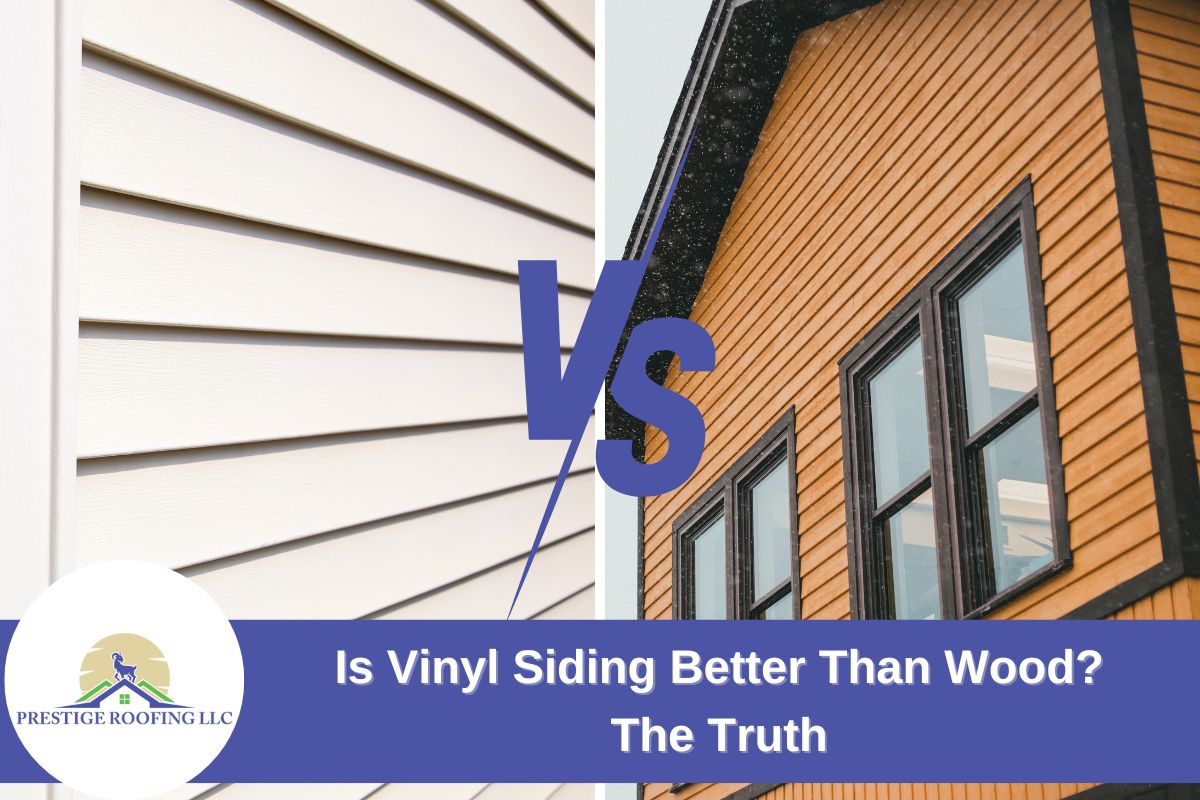Few home improvement projects are as important as replacing your home’s siding. Think about it: your siding is the exterior layer that protects your house from all kinds of elements, including harsh weather, dust, debris, and even pesky animals. Making sure it’s in good shape is crucial for the overall health of your home!
There are a variety of siding options available, but today we compare two of the most popular siding options out there: vinyl and wood siding. Both have their pros and cons, and the right choice really depends on what matters most to you.
From cost and lifespan to maintenance needs, we take up all the crucial factors that will likely impact your decision. Let’s get started.
#1 Vinyl vs. Wood: Manufacturing Process

Vinyl siding is made from polyvinyl chloride (PVC), a type of plastic. Manufacturers heat and mold the material into panels that can mimic the look of wood grain. It’s a mass-produced, uniform process, which helps keep costs low and ensures consistency from piece to piece.
Wood siding, on the other hand, is crafted from natural timber. It can be made from a variety of different woods like cedar, pine, redwood, or fir, each with its own look and performance.
#2 The Cost of Vinyl Siding vs. Wood Siding: Which Is Cheaper?
Siding projects involve a considerable investment. So it is likely that if you’re comparing any two siding materials, your primary concern will be the difference in price.
Upfront Costs:
- Vinyl Siding Average Cost: $11,000
- Wood Siding Average Cost: $14,000
Vinyl siding is slightly more affordable. On average, installing vinyl on a 1,500 square foot home can cost between $5,500 and $12,000. Materials alone usually run between $4 and $5 per square foot.
Wood siding, on the other hand, is more expensive. You’re looking at around $9,000 to $16,000 for installation on the same-sized home. Material costs vary more widely, ranging from $3 to $10 per square foot, depending on the type of wood you choose.
Long-Term Costs: The Price of Maintenance
Upfront costs are just one part of the picture. What will the siding cost you over the next 10, 15, or 20 years?
Vinyl siding wins in this category as well. It’s low maintenance, which means you don’t need to paint, stain, or seal it. An occasional rinse with a garden hose or mild soap is usually enough to keep it looking clean.
Wood siding needs a lot more care. To keep it in good shape, you’ll need to paint or stain it every few years.
#3 Lifespan and Durability
When installed and maintained properly, vinyl siding can last for about 30 to 50 years or even more. It holds up well against moisture and doesn’t attract insects. It also doesn’t rot or warp, making it a strong choice for humid or rainy climates.
Wood siding typically lasts between 20 and 40 years, but that depends heavily on the type of wood you choose and how well you maintain it. Cedar, for example, naturally resists rot and insects better than pine or fir.
However, wood is more vulnerable to moisture. Without proper sealing, it can swell, crack, or warp, so if you live in a wet or humid climate, wood will need extra protection to stand the test of time.
#4 Weather Resistance
Vinyl is moisture-resistant, so you don’t have to worry about rot or mold, but extreme temperatures can affect it. Intense sun and heat may warp or fade the siding boarding while extreme cold can make the boards brittle and more likely to crack.
Wood tends to expand and contract during extreme temperature changes, and it tends to be high-maintenance in wet environments. Water can seep in, causing the wooden siding board to expand, crack, or decay over time, but if you live in a drier, more temperate climate and you’re willing to maintain it, wood might work out well.
#5 What Looks Better?
Over the years, appearances have become one of the most important deciding factors for homeowners. After all, the siding covers your entire home, and it’s important that you get the look that matches your vision.
Wood siding wins in terms of natural beauty and customization since you can choose from numerous species of wood and styles.
Vinyl house siding has come a long way. Today, there are more styles, textures, and colors than ever before, such as board-and-batten, vertical, or clapboard. What we also like is that the colors are ingrained in the vinyl siding itself.
You can even find vinyl siding options that look like wood. That being said, if your goal is maximum curb appeal, and you’re going for a classic or high-end look, wood is tough to beat. But for clean, modern, and practical? Vinyl holds its own.
#6 Resale Value: Does It Pay Off?
Both vinyl and wood siding can give you a solid return when it comes time to sell. The key difference lies in the type of buyer and the style of home.
Vinyl siding has a strong track record for added resale value. According to Remodeling Magazine’s Cost vs. Value Report, vinyl siding replacement can recoup about 80.2% of the project cost. This is quite impressive and makes it one of the more cost-effective exterior upgrades. Its clean look, durability, and low maintenance are attractive to buyers, especially those who don’t want to take on a full renovation project yet.
Wood is not far behind, either. While more expensive upfront and to maintain, it offers strong curb appeal, especially in historic neighborhoods or higher-end markets. Its natural appearance gives homes a warm, timeless feel that many buyers love, but maintenance needs can be a concern.
#7 Environmental Impact: Which One’s Greener?
Wood siding is made from natural, renewable materials. If it comes from a responsibly managed forest, it’s a sustainable option, and it’s also recyclable at the end of its lifespan.
Vinyl siding is made from PVC, a type of plastic. It’s not biodegradable, and manufacturing it involves fossil fuels and emissions. However, some vinyl products are now made with recycling in mind and can be more energy efficient when combined with foam insulation.
#8 Insulation and Energy Efficiency Needs!
Neither vinyl nor wood is a great insulator on its own. Wood has a slightly higher natural R-value (a measure of thermal resistance), but both materials need to be paired with insulation for the best results.
Vinyl siding often comes with, or allows, for integrated foam insulation. You can find insulated vinyl siding with pre-installed foam backing and thicker panels, making it easy to increase energy efficiency. With wood, adding insulation takes more work and can impact how the siding is installed.
Final Thoughts
There’s no one-size-fits-all answer, but now you’ve got the facts! At the end of the day, your siding should fit your lifestyle, your home, and your goals. Whether that means going with low-maintenance vinyl or investing in classic wood, we’re here to help you make it happen.
Need help deciding what’s right for your home? Our team is happy to walk you through the options. At Prestige Roofing LLC, we have the expertise to install both vinyl and wood siding. We can answer your questions and give you a quote that fits your needs. Reach out today at (920) 791-0414, and we will be happy to help.

